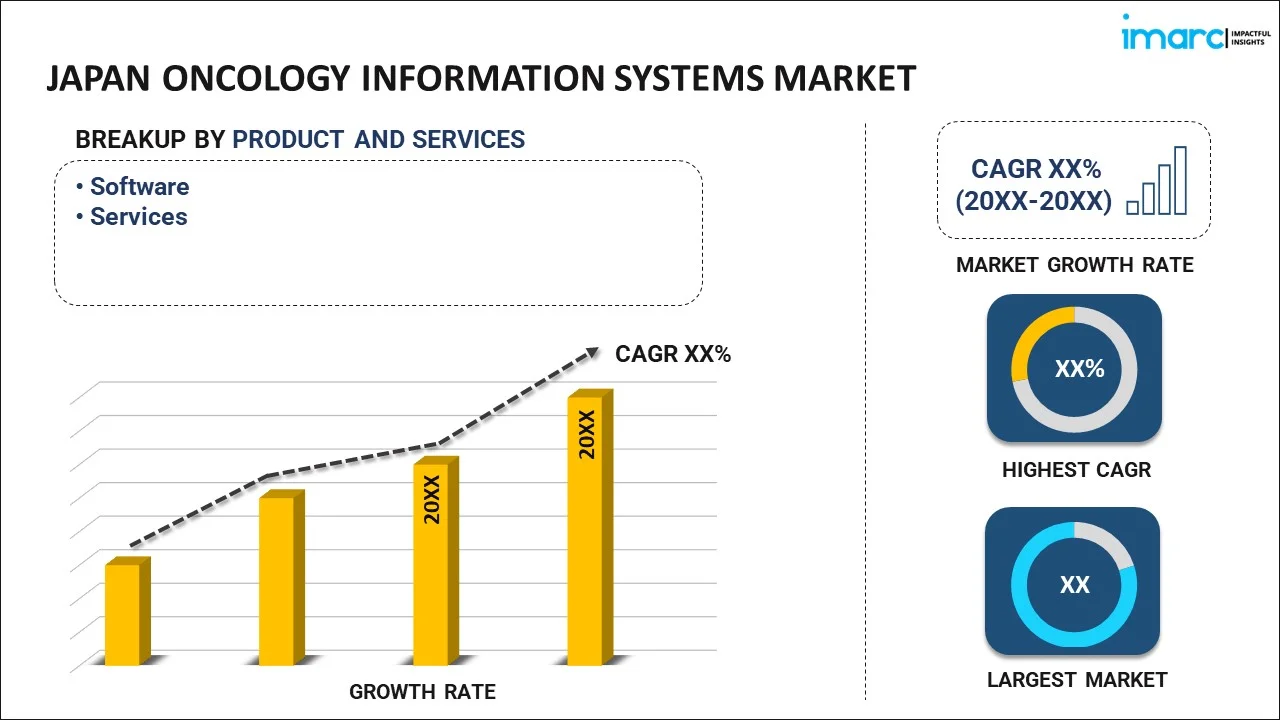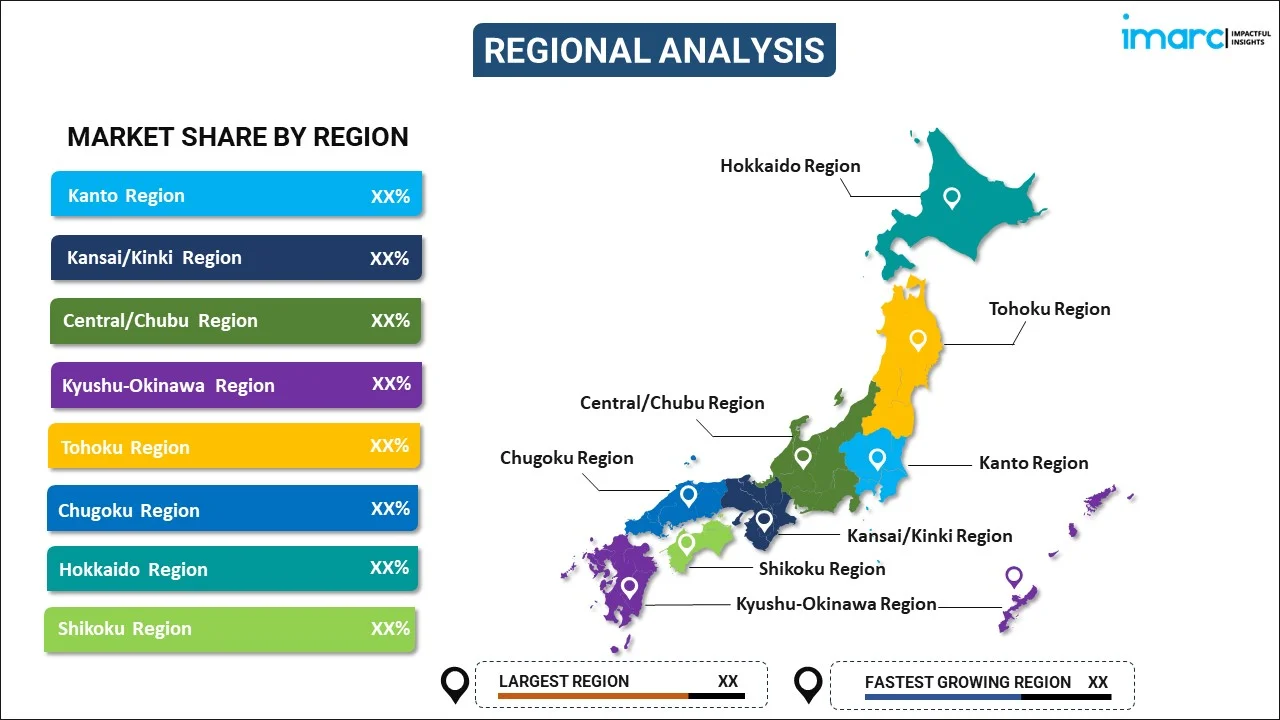
Japan Oncology Information Systems Market Report by Product and Service (Software, Services), Application (Radiation Oncology, Medical Oncology, Surgical Oncology), End User (Hospitals and Diagnostic Imaging Centers, Ablation Care Centers and Cancer Care Centers, Government Institutions, Research Facilities), and Region 2025-2033
Market Overview:
Japan oncology information systems market size reached USD 119.1 Million in 2024. Looking forward, IMARC Group expects the market to reach USD 248.1 Million by 2033, exhibiting a growth rate (CAGR) of 8.5% during 2025-2033. The rising incidence of cancer, coupled with the increasing need for efficient systems to manage patient data, treatment plans, and outcomes, is driving the market.
|
Report Attribute
|
Key Statistics
|
|---|---|
|
Base Year
|
2024 |
|
Forecast Years
|
2025-2033 |
|
Historical Years
|
2019-2024
|
| Market Size in 2024 | USD 119.1 Million |
| Market Forecast in 2033 | USD 248.1 Million |
| Market Growth Rate (2025-2033) | 8.5% |
Oncology information systems (OIS) are specialized software solutions designed to streamline and optimize the management of cancer care within healthcare institutions. These systems play a crucial role in the field of oncology by facilitating the efficient storage, retrieval, and analysis of patient data related to cancer diagnosis and treatment. OIS typically encompasses a range of functionalities, including electronic health records (EHRs) tailored to cancer patients, treatment planning and management tools, scheduling and appointment tracking, and integration with medical imaging and laboratory systems. OIS aims to improve the coordination of care among multidisciplinary oncology teams, ensuring that healthcare professionals have access to up-to-date patient information and treatment plans. They also aid in compliance with regulatory requirements and quality assurance standards in cancer care. By centralizing and digitizing oncology-related data, OIS not only enhances patient care but also supports research efforts by providing valuable data for clinical trials and outcome analysis.
Japan Oncology Information Systems Market Trends:
The oncology information systems market in Japan is multifaceted and interconnected, propelling this sector toward substantial growth. Firstly, the escalating incidence of cancer is a key catalyst. As the prevalence of cancer continues to rise, healthcare providers are seeking more efficient ways to manage patient data and treatment regimens. Consequently, OIS solutions are in high demand to streamline oncology workflows. Moreover, the increasing emphasis on personalized medicine is driving OIS adoption. With advancements in genomics and targeted therapies, oncologists require sophisticated tools to tailor treatments to individual patients. OIS systems enable the seamless integration of patient data, genomic information, and treatment plans, ensuring precise and personalized care. Additionally, regulatory requirements and the need for compliance are influencing OIS adoption. Healthcare organizations must adhere to strict data privacy and security regulations, and OIS solutions provide robust features to meet these requirements. Furthermore, the escalating application of telemedicine and remote monitoring in oncology care to manage remote consultations, monitor patient progress, and share information among healthcare professionals is expected to drive the oncology information systems market in Japan during the forecast period.
Japan Oncology Information Systems Market Segmentation:
IMARC Group provides an analysis of the key trends in each segment of the market, along with forecasts at the country level for 2025-2033. Our report has categorized the market based on product and services, application, and end user.
Product and Services Insights:

- Software
- Patient Information Systems
- Treatment Planning Systems
- Services
- Consulting Services
- Implementation Services
- Maintenance Services
The report has provided a detailed breakup and analysis of the market based on the product and services. This includes software (patient information systems and treatment planning systems) and services (consulting services, implementation services, and maintenance services).
Application Insights:
- Radiation Oncology
- Medical Oncology
- Surgical Oncology
A detailed breakup and analysis of the market based on the application have also been provided in the report. This includes radiation oncology, medical oncology, and surgical oncology.
End User Insights:
- Hospitals and Diagnostic Imaging Centers
- Ablation Care Centers and Cancer Care Centers
- Government Institutions
- Research Facilities
The report has provided a detailed breakup and analysis of the market based on the end user. This includes hospitals and diagnostic imaging centers, ablation care centers and cancer care centers, government institutions, and research facilities.
Regional Insights:

- Kanto Region
- Kansai/Kinki Region
- Central/ Chubu Region
- Kyushu-Okinawa Region
- Tohoku Region
- Chugoku Region
- Hokkaido Region
- Shikoku Region
The report has also provided a comprehensive analysis of all the major regional markets, which include Kanto Region, Kansai/Kinki Region, Central/ Chubu Region, Kyushu-Okinawa Region, Tohoku Region, Chugoku Region, Hokkaido Region, and Shikoku Region.
Competitive Landscape:
The market research report has also provided a comprehensive analysis of the competitive landscape in the market. Competitive analysis such as market structure, key player positioning, top winning strategies, competitive dashboard, and company evaluation quadrant has been covered in the report. Also, detailed profiles of all major companies have been provided.
Japan Oncology Information Systems Market Report Coverage:
| Report Features | Details |
|---|---|
| Base Year of the Analysis | 2024 |
| Historical Period | 2019-2024 |
| Forecast Period | 2025-2033 |
| Units | Million USD |
| Scope of the Report | Exploration of Historical Trends and Market Outlook, Industry Catalysts and Challenges, Segment-Wise Historical and Future Market Assessment:
|
| Product and Services Covered |
|
| Applications Covered | Radiation Oncology, Medical Oncology, Surgical Oncology |
| Regions Covered | Hospitals and Diagnostic Imaging Centers, Ablation Care Centers and Cancer Care Centers, Government Institutions, Research Facilities |
| Customization Scope | 10% Free Customization |
| Post-Sale Analyst Support | 10-12 Weeks |
| Delivery Format | PDF and Excel through Email (We can also provide the editable version of the report in PPT/Word format on special request) |
Key Questions Answered in This Report:
- How has the Japan oncology information systems market performed so far and how will it perform in the coming years?
- What has been the impact of COVID-19 on the Japan oncology information systems market?
- What is the breakup of the Japan oncology information systems market on the basis of product and services?
- What is the breakup of the Japan oncology information systems market on the basis of application?
- What is the breakup of the Japan oncology information systems market on the basis of end user?
- What are the various stages in the value chain of the Japan oncology information systems market?
- What are the key driving factors and challenges in the Japan oncology information systems?
- What is the structure of the Japan oncology information systems market and who are the key players?
- What is the degree of competition in the Japan oncology information systems market?
Key Benefits for Stakeholders:
- IMARC’s industry report offers a comprehensive quantitative analysis of various market segments, historical and current market trends, market forecasts, and dynamics of the Japan oncology information systems market from 2019-2033.
- The research report provides the latest information on the market drivers, challenges, and opportunities in the Japan oncology information systems market.
- Porter's five forces analysis assist stakeholders in assessing the impact of new entrants, competitive rivalry, supplier power, buyer power, and the threat of substitution. It helps stakeholders to analyze the level of competition within the Japan oncology information systems industry and its attractiveness.
- Competitive landscape allows stakeholders to understand their competitive environment and provides an insight into the current positions of key players in the market.
Need more help?
- Speak to our experienced analysts for insights on the current market scenarios.
- Include additional segments and countries to customize the report as per your requirement.
- Gain an unparalleled competitive advantage in your domain by understanding how to utilize the report and positively impacting your operations and revenue.
- For further assistance, please connect with our analysts.
 Inquire Before Buying
Inquire Before Buying
 Speak to an Analyst
Speak to an Analyst
 Request Brochure
Request Brochure
 Request Customization
Request Customization




.webp)




.webp)












